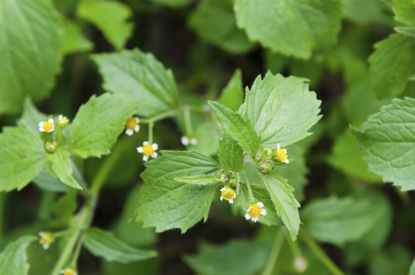Hairy Galinsoga Control: Tips For Controlling Shaggy Soldier Weeds


Shaggy soldier weed plants are serious weed pests in many areas of North America. The plants are also known as Galinsoga weeds and are a competitive plant that can reduce yield by up to half in row crops. The weed poses most problems to organic gardeners, as mechanical efforts do not provide successful hairy Galinsoga control. Additionally, Galinsoga weeds spread like wildfire through air dissemination but also when the hairy, sticky seeds get attached to animals, pant legs, machinery, and other objects. Get the Galinsoga facts so you can safely and successfully combat this tenacious weed.
Galinsoga Facts
Any gardener familiar with shaggy soldier weed plants understands the challenges faced with their eradication. This stoic weed can take anything you can dish out and still merrily leave behind offspring to plague you the next year. In non-crop situations, you can bring out the chemical warfare and fairly easily combat these weeds; but in food crop situations, the battle isn’t so simple and often the soldier weeds win. Controlling shaggy soldier weeds in cropland may require fallow land, crop rotation, and some judiciously timed herbicides. Galinsoga is a self-sowing herbaceous annual. Plants are low growing and may get from 5 to 30 inches (13-76 cm.) in height. Leaves and stems are densely hairy, and the plant produces a composite flower head capable of developing numerous seeds. Flowers are ¼ inch (6 mm.) wide and comprised of both rayed and disc florets. Each plant can produce up to 7,500 seeds, a frustrating detail to most gardeners. Seeds come with stiff hairs that latch onto anything nearby. This only adds to the frustrations inherent to hairy Galinsoga control, as the seed is easily caught by the wind and dispersed.
Natural Hairy Galinsoga Control
Early tilling may have some effect on seed germination. This is because shaggy soldier weed seed germinates more readily in lightly tilled soil that has been turned shallowly. If plants are already present, tilling may have a limited effect due to their ability to regenerate from cut stems and re-root if conditions are moist. Summer cover crops can help smother the plants. The most effective are several species of Sorghum. Organic mulch applied in a thick layer or some black plastic are other effective, natural measures. You must be vigilant as there can be three to five generations of the plant per season, dependent upon your zone. Other methods include leaving an area unplanted for a season, rotating crops, and cleaning machinery to avoid spreading the seed.
Chemical Control of Galinsoga
Galinsoga is a persistent plant with numerous seasonal generations and sticky seeds that have a broad travel capacity. Controlling shaggy soldier weed with herbicides also has its downsides but may be a more effective choice in open fields prior to crop seeding. Combat with this plant may require chemical intervention. Herbicides in topical, spot application should commence before the seed head forms. In large landscapes where infestations are annual, apply herbicides before any seeding has been done. Prepare the area as you would for seeding but wait until shaggy soldier has appeared. Then use an herbicide with no soil residue. Plant crop seeds a week after herbicide application. In areas where no crops will be grown, an application of 2,4D applied at a rate of 2 to 4 pints per acre (1-2 L. per 4,050 sq. m.) has been shown to achieve effective control.
Gardening tips, videos, info and more delivered right to your inbox!
Sign up for the Gardening Know How newsletter today and receive a free download of our most popular eBook "How to Grow Delicious Tomatoes."

Bonnie Grant is a professional landscaper with a Certification in Urban Gardening. She has been gardening and writing for 15 years. A former professional chef, she has a passion for edible landscaping.
-
 Urban Beekeeping Guide: Top Tips For Raising Bees In The City
Urban Beekeeping Guide: Top Tips For Raising Bees In The CityUrban beekeeping can be a rewarding and appreciated pastime, but first be sure it’s legal in your city and learn the ropes of beekeeping.
By Mary Ellen Ellis
-
 2024 Plant Of The Year: Why Experts Say Philodendron Is The “It” Plant Of The Year
2024 Plant Of The Year: Why Experts Say Philodendron Is The “It” Plant Of The YearWe aren’t surprised that philodendron was designated the plant of the year. Versatile, easy-care and lovely, it’s the houseplant of the year 2024!
By Bonnie L. Grant